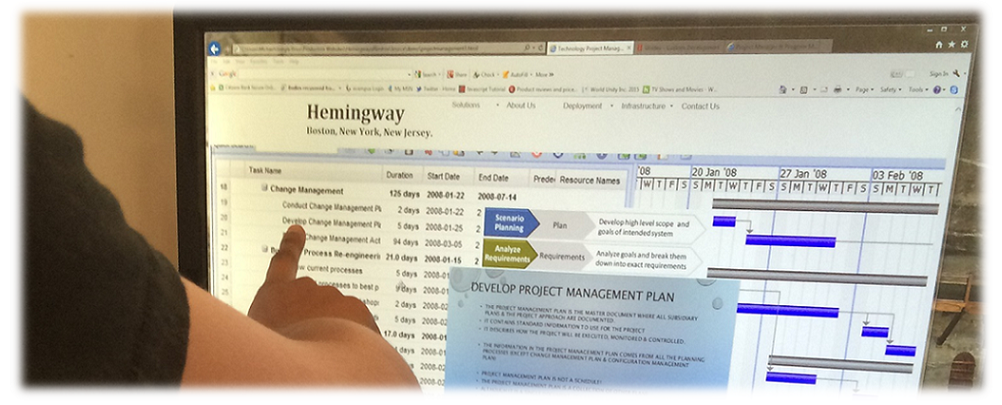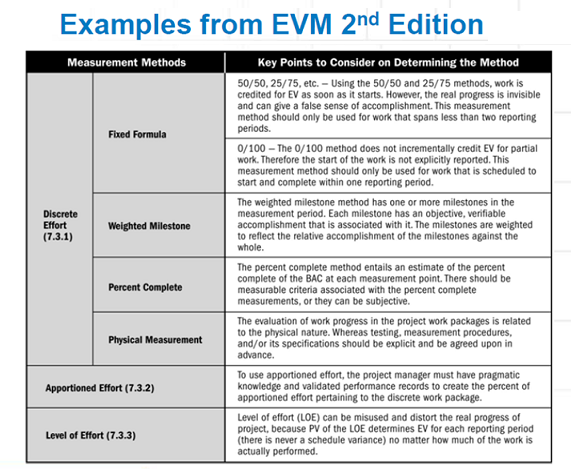|
|
Performance: Reporting and EVM (Earned Value Management)

Earned value management (EVM), or Earned value project/performance management (EVPM) is a project management technique for measuring project performance and progress in an objective manner.
Application example
- Project A has been approved for a duration of 1 year and with the budget of X. It was also planned the project spends 50% of the approved budget in the first 6 months.
- If now 6 months after the start of the project a Project Manager would report that he has spent 50% of the budget, one can initially think, that the project is perfectly on plan. However in reality the provided information is not sufficient to come to such a conclusion.
- The project can spend 50% of the budget, while finishing only 25% of the work, which would mean the project is not doing well; or the project can spend 50% of the budget, while completing 75% of the work, which would mean that project is doing better than planned. EVM is meant to address such and similar issues.
Implementations of EVM can be scaled to fit projects of all sizes and complexities. EVM is based on the principle of “Earned Time”. The measurement methdology is illustrated in the graphic above.
Foundational Principle – The true understanding of cost performance and schedule performance relies first on measuring technical performance objectively. This is the foundational principle of EVM and does not depend on size or complexity.
EVM concepts (Scaling – Simple to advanced implementations)
All or Nothing Threshold (advanced) - projects above the threshold require a full-featured (complex) EVM system and projects below the threshold are exempted.
Project size and Skill Levels – (simple) Scale EVM implementation according to the project at hand and skill level of the project team.
The following are steps for defining EVM based on technical performance:
- Define work (based on WBS) - This is typically done in a hierarchical arrangement called a work breakdown structure (WBS) although the simplest projects may use a simple list of tasks. In either case, it is important that the WBS or list be comprehensive. It is also important that the elements be mutually exclusive, so that work is easily categorized in one and only one element of work. The most detailed elements of a WBS hierarchy (or the items in a list) are called activities (or tasks).
- Assign a Value (Planned value or Point value) - called planned value (PV), to each activity. For large projects, PV is almost always an allocation of the total project budget, and may be in units of currency (e.g., dollars or euros) or in labor hours, or both. However, in very simple projects, each activity may be assigned a weighted “point value" which might not be a budget number. Assigning weighted values and achieving consensus on all PV quantities yields an important benefit of EVM, because it exposes misunderstandings and miscommunications about the scope of the project, and resolving these differences should always occur as early as possible. Some terminal elements cannot be known (planned) in great detail in advance, and that is expected, because they can be further refined at a later time.
- Define Earning rules (0/100, 50/50, 25/75, or 20/80) - The simplest method is to apply just one earning rule, such as the 0/100 rule, to all activities. Using the 0/100 rule, no credit is earned for an element of work until it is finished. A related rule is called the 50/50 rule, which means 50% credit is earned when an element of work is started, and the remaining 50% is earned upon completion. Other fixed earning rules such as a 25/75 rule or 20/80 rule are gaining favor, because they assign more weight to finishing work than for starting it, but they also motivate the project team to identify when an element of work is started, which can improve awareness of work-in-progress. These simple earning rules work well for small or simple projects because generally each activity tends to be fairly short in duration.
- The final step is to execute the project according to the plan and measure progress. When activities are started or finished, EV is accumulated according to the earning rule. This is typically done at regular intervals (e.g., weekly or monthly), but there is no reason why EV cannot be accumulated in near real-time, when work elements are started/completed. In fact, waiting to update EV only once per month (simply because that is when cost data are available) only detracts from a primary benefit of using EVM, which is to create a technical performance scoreboard for the project team.
Process Approach (Based on EVM2)
Initiation
Organize project – (inputs) Project charter, stakeholder strategy, requirements docs. (outputs) scope plan & baseline, WBS and dictionary
- Assign responsibility – (inputs) scope baseline (outputs) organizational breakdown structure OBS), responsibility assignment matrix (RACI)
- Schedule work – (inputs) scope baseline, resource plan, and duration estimates). (outputs) integrated master schedule)
- Establish budget – (inputs) project charter, Responsibility assignment matrix, schedule baseline.
- Determine measurement methods – (inputs) requirements documents, statement of work, scope baseline, IMS, project budget (outputs) performance measurement plan, performance measurement methods, control account plan updates.
- Establish PMB (Project Management Baseline) – (inputs) project management plan, PMB, change requests (output) PMB updates, project management plan updates, change request updates.
Execution, Monitoring, and Control
- Use project data – (inputs) project management plan, work performance information (outputs) work performance measurements, budget forcasts, corrective and preventive action plans
- Maintain PMB – (inputs) project management plan, PMB, change requests. (output) PMB updates, project management plan updates, change request updates.
|